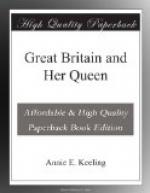There are many local preachers among the soldiers, and at least two have left the ranks to become ministers.
On the Mission field, soldiers render valuable aid to the missionary in building chapels, distributing tracts, and often teaching and preaching to the natives and others. Thus, whilst helping to hold the empire for their Queen, they are hastening on the day when all the kingdoms of the world shall be the kingdom of our Lord and of His Christ.
This deeply interesting work in the Army and Royal Navy is appropriately mentioned in connexion with our Home and Foreign Missions, both intimately concerned in its maintenance and management. It is right to mention that the Soldiers’ and Sailors’ Homes described are free to all members of H.M.’s sea and land forces, irrespective of religious denomination.
PART II.
One great event in Methodist history since 1837 now calls for notice—the assembling of the first Oecumenical Conference in Wesley’s Chapel, City Road, London, in 1861. This idea was in strict keeping with the spirit Wesley discovered when, five weeks before his death, he wrote to his children in America: “See that you never give place to one thought of separating from your brethren in Europe. Lose no opportunity of declaring to all men that the Methodists are one people in all the world, and that it is their full determination so to continue,
“’Though mountains
rise, and oceans roll,
To sever us in vain.’”
The growing affection among Methodists of all branches made the idea of an Oecumenical Conference practicable.
[Illustration: Sir Francis Lycett.]
The suggestion took form at the Joint Conference of the Methodist Episcopal Church of America in 1876. The American Methodists sent a delegate to the British Conference, proposing a United Conference which should demonstrate to the world the essential oneness in doctrine, spirit, and principle of all the Churches which historically trace their origin to John Wesley; such a manifestation, it was hoped, would strengthen and perpetuate that unity.




